________________
PROCEEDINGS OF THE SEMINAR-SECOND DAY
Brhatsaṁhitā to which it is greatly indebted. The text, Dr. Shastri said, belongs to the Digambara sect of Jainism, though a critical examination of its contents reveals the fact that, in all probability, it was originally a Brāhmaṇical work and was given a Jain appearance at a later date by adding a few Jain elements here and there. Prof. D. C. Sircar observed that the Jain traditions regarding the contests between Bhadrabāhu and Varāhamihira remind one of similar traditions about the rivalry between Guņādhya and Sarvavarman as found in the Kathāsaritsāgara. Prof. Sircar also pointed out how Varāhmihira is associated with Vikramāditya in some traditions and with the Nandas in others though there was no king named Vikramaditya before the Gupta age. Dr. Shastri said that the Digambara tradition connects Bhadrabāhu with Candragupta Maurya and the Svetāmbara tradition with the Nandas, so that Varāhamihira, mentioned as a contemporary of Bhadrabāhu, is placed by them in the same age. Dr. Upreti did not accept the idea that Varāhamihira superseded Āryabhața. Dr. Shastri did not consider the point as relevant to his paper. Dr. S. R. Das wanted to know when the Magas came to India, because Varābamihira is referred to by Dr. Shastri as a Maga Brāhmaṇa. Prof. Sircar and Dr. Shastri thought that the Magas came to India with the Scythians who entered the Indus Valley from Eastern Iran. Prof. Sircar observed that, in the second century A. D.,' Ptolemy mentions the Maga-Brāhmaṇas settled even in the Far South of India.
Sm. S. Sengupta next read her paper on “Jain Cosmography'. She dealt with the Jain theory of the origin and shape of the universe. Jain cosmography, she pointed out, is based on the ideas of the Brāhmaṇical Purāņas, but is represented as different from them in certain respects. The Jains criticised the Brāhmaṇical and Buddhist view points, according to which the world is created and destroyed by reason of the combination and disintegration of a number of elements (jada) and consciousness (cetana), which are eternal. Prof. Sircar observed that the Jains exhibited a passion for
.
Jain Education International
For Private & Personal Use Only
www.jainelibrary.org




